A Fitbit is a wearable device used to keep track your overall daily physical activity levels. The original Fitbits were fairly simple belt clips or wristbands that just counted your daily steps.
Now, however, the latest Fitbits are incredibly advanced activity trackers, counting how many flights of stairs you climb, how much time you spend doing different types of exercise, and what your total energetic expenditure is. Even the phrase ‘Fitbit’ has come to mean something more broad than just the line of activity trackers made by the San Francisco based company recently purchased by Google.
Much like Kleenex, the word ‘Fitbit’ now means any kind of wearable device that’s explicitly designed to track your activity, especially if it’s worn at the wrist. People call these “fitness trackers”, but really they are physical activity trackers: even if you do not exercise, a Fitbit is incredibly handy for monitoring your overall daily physical activity.
With this explosion in popularity of Fitbits, they are more and more being seen as a key component for weight loss and long-term health. Our research team set out to determine which model of Fitbit is the best, and whether any of the alternatives offered by other companies are worth a look.
The big picture
A Fitbit is a great tool to track your physical activity levels, estimate your daily caloric expenditure, and even keep track of your sleep. After reviewing a wide range of products for features, ease of use, and accuracy, we found that the Fitbit Charge 3 is the best Fitbit on the market right now, thanks to its great cross-platform app compatibility and its ability to capture sleep, activity, and heart rate data with good precision.
Rankings
1. Fitbit Charge 3
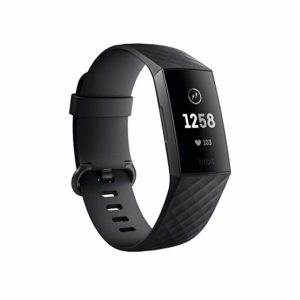
Click here for the lowest price on Amazon
The Fitbit Charge 3 is the best Fitbit on the market thanks to its great activity tracking features, heart rate monitoring, and an elegant touchscreen. If there’s a feature that exists on any fitness tracker on the market, you’ll find it on the Fitbit Charge 3.
Why we like it: The Fitbit Charge 3 is totally waterproof, has excellent step counting and activity recognition capabilities, and has pretty solid smartwatch connectivity features, like app alerts on your Fitbit.
It monitors your heart rate round-the-clock and provides info on your sleep quality as well. It also performs well in scientific studies that validate its performance against research-grade devices.
Flaws: If you want a fully fledged smartwatch, the Fitbit Charge 3 comes up a little short, but aside from that, it’s hard to fault this Fitbit for much.
2. Garmin Vivosmart 4
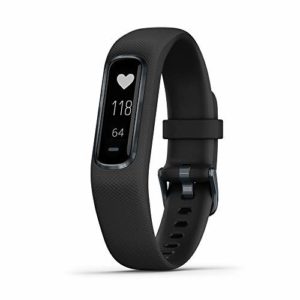
Click here for the lowest price on Amazon
Garmin has risen from being a narrowly-focused manufacturer of sports GPS watches to a heavy hitter in the fitness tracker and smartwatch industry. The Vivosmart 4 has the unmistakable sleek look of a Fitbit, with a mono color screen that displays heart rate, step count, and other quick stats.
Why we like it: Garmin has great expertise in cardiovascular fitness, and they put it to use in this fitness tracker: the device features a heart rate monitor that can improve estimates of your caloric expenditure, estimate your maximum cardiovascular fitness, and tell you your resting heart rate. On top of that, it’s got fantastic battery life, only requiring a recharge once per week on average.
Flaws: The display screen is not particularly crisp, and Garmin doesn’t have the same kind of activity tracking features you would expect from a bona fide smartwatch. The heart rate monitor is a nice feature but it can struggle in activities with lots of aggressive arm motion, like sprinting.
3. Apple Watch Series 5
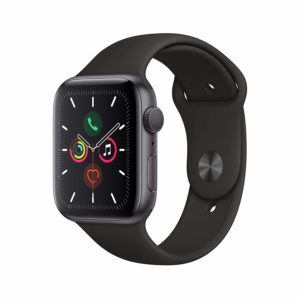
Click here for the lowest price on Amazon
The Apple Watch is undoubtedly the dominant smartwatch on the market—it completely crushes the competition when it comes to functionality. Beyond just being a smartwatch company, Apple has been putting in huge amounts of work into its fitness tracking capabilities, and many of these new features are incorporated into the Apple Watch Series 5, which makes a remarkably good fitness tracker.
Why we like it: Apple’s heart rate monitoring technology is some of the best on the market, and their activity recognition has improved leaps and bounds in recent years. Alongside these features, you get phenomenal smartphone integration and app functionality as well.
Flaws: If all you want to do is count your steps and estimate your daily caloric expenditure, an Apple Watch is definitely overkill. Plus, if you don’t have an Apple phone, there isn’t much you can do with an Apple Watch. If you are looking for something simple, rugged, and with great battery life, you’ll want a different device.
4. Fitbit Versa 2
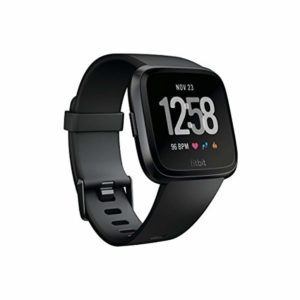
Click here for the lowest price on Amazon
The Versa 2 is Fitbit’s take on the dual-purpose smartwatch / fitness tracker. It has a large, color touchscreen and comes paired with Amazon Alexa as a virtual assistant. The Versa 2 incorporates all of the activity tracking features Fitbit is famous for.
Why we like it: If you’ve started with an older model of Fitbit but want to upgrade to something that take better advantage of smartphone connectivity, the Versa 2 is a good pick: you get all of the industry-leading fitness tracking features that Fitbit has developed, plus some standard smartwatch capabilities.
Flaws: Compared to the dominant smartwatch on the market (the Apple Watch), the Versa seems a little clunky. For example, you can only send quick replies to text messages, and voice messaging only works on Android.
The Versa 2 also does not have standalone GPS capabilities like Garmin’s flagship smartwatch, so it’s a little hampered on the sports end as well. It can, however, “piggyback” off your smartphone’s GPS connection to show you running or cycling speed.
5. Fitbit Ionic
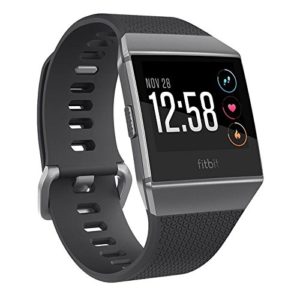
Click here for the lowest price on Amazon
In many ways, the Fitbit Ionic is similar to the Fitbit Versa 2. It is a fully fledged smartwatch that still offers all the fitness tracking tech you’d expect in a Fitbit.
Why we like it: For runners and cyclist, the Ionic is the clear winner over the Versa 2 thanks to its integrated GPS.
You can go for a run and leave your smartphone at home, and still get accurate speed and distance data. The sharp edges of the Ionic are also a nice contrast against many other smartwatches that use softer, smoother lines in their design.
Flaws: Compared to the Versa 2, the Ionic doesn’t have Amazon Alexa integration, but aside from that, it shares many of the same features and flaws.
It’s probably overdoing it if you mostly care about calories burned and steps taken, and it doesn’t have quite as much capabilities as an Apple Watch for users who already have an iPhone.
6. Fitbit Inspire HR
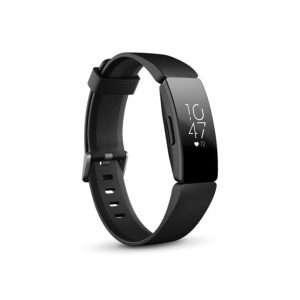
Click here for the lowest price on Amazon
The FItbit Inspire is a simpler, sleeker version of the Charge 3. It still features many of the same basic features, like steps taken, calories burned, and heart rate, so if all you want is a simple device that tracks heart rate as well as daily steps, the Inspire HR is a good pick.
Why we like it: Since the Flex 2 was discontinued, the Inspire HR is the best model of Fitbit still in production for people who are not technology geeks. If you want something that has all the great technology Fitbit has to offer, but without any complicated features and functionality, the Inspire HR works great for your needs.
Flaws: Compared to the Charge 3, the Inspire HR has fewer exercise modes and apps, shorter battery life, and not quite as many sensors. The Inspire HR, for example, can’t analyze blood oxygenation level, but the Charge 3 can.
7. Fitbit Ace 2
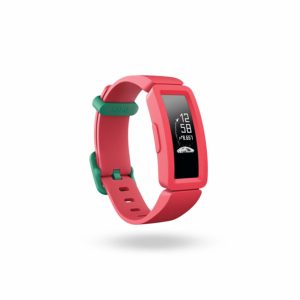
Click here for the lowest price on Amazon
Researchers and doctors say that establishing good physical activity habits starts in childhood. If you’re looking for a Fitbit that works great for kids, the Fitbit Ace 2 is exactly what you’ve been searching for. The Ace 2 is simple, colorful, and fun: it tracks steps, minutes of activity, and even sleep.
Why we like it: Exercise is incredibly important for kids, both short-term and long-term. The Fitbit Ace 2 is an excellent way to help engrain good fitness and health habits at a young age, with just three simple numbers: steps taken, minutes of activity, and duration of sleep. The Fitbit Ace 2 is also completely waterproof, so your kids can even take it swimming.
Flaws: As you might guess, the functionality of the Fitbit Ace 2 is pretty limited compared to the flagship devices that are designed for adults. Once your kids are a little older, they might want to graduate to a more sophisticated Fitbit.
8. Fitbit Flex 2
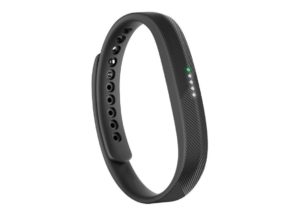
Click here for the lowest price on Amazon
The original Fitbit Flex was the breakout device from Fitbit: the iconic unmarked black wristband catapulted Fitbit from an obscure Bay-area startup to a household name. The Flex 2 is Fitbit’s follow-up, and features the same sleek, hyper-minimalist look with upgraded features.
Why we like it: The actual tracker in the Fitbit Flex is a tiny rectangular box that slides into the bracelet, which means you can pick up many different colors and styles of wristband to pair it with different outfits.
The Flex 2 has activity recognition that can identify when you are running, swimming, biking, or using the elliptical, and it uses tiny colored LEDs to show your progress towards your daily goals.
Flaws: If you are looking for more advanced features available on-board, you’ll have to look elsewhere, as there’s no real screen on this device. Moreover, it isn’t being manufactured anymore, so the Flex 2 isn’t going to get whatever new features Fitbit comes out with in the future.
9. Lintelek Fitness Tracker
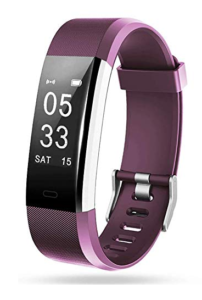
Click here for the lowest price on Amazon
Thanks to the success of name-brand Fitbits, many off brand fitness trackers have cropped up that offer many of the same basic features for a fraction of the price.
One of the best of these is the Lintelek Fitness Tracker, a simple wristband that is a good choice if all you care about is knowing your daily steps, energy expenditure, and heart rate.
Why we like it: At first glance, it’s almost impossible to distinguish this device from a name-brand Fitbit, since it’s got all the features you’ll find on the latest flagship models: daily steps, energy burned, and heart rate.
Flaws: Since Lintelek is a smaller company, it’s not clear how accurate their step counting and heart rate monitoring is. If you are mostly using your fitness tracker just to count your steps to make sure you get close to or above 10,000, that’s probably not a big deal, but if knowing your heart rate accurately or getting proper activity tracking is important to you, opt for a higher end device.
10. LetsFit Smart Watch
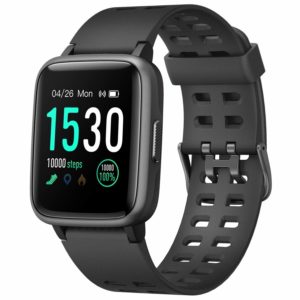
Click here for the lowest price on Amazon
Think smartwatches are just for high-end users? Think again. LetsFit aims to bring smart watch technology to the masses with its smartwatch technology that doubles as a fitness tracker.
Why we like it: Though you definitely aren’t getting the level of functionality and reliability that you’d get in an Apple Watch, you still get a surprising amount of functionality, like a large touch screen, long battery life, heart rate tracking, and step counts.
Flaws: If you’re expecting cutting-edge apps and abilities, you’re bound to be disappointed with the LetsFit: it can’t compete with top of the line smartwatches, but that shouldn’t be surprising. As with other off-brand Fitbit manufacturers, the accuracy of the heart rate tracking and step counting is probably not as good as a Fitbit or Garmin or Apple brand device.
Who should buy a Fitbit?
Given how important your overall physical activity level is for weight loss, weight maintenance, and long-term health, it isn’t hard to make a case that just about anyone can benefit significantly from a Fitbit. People are notoriously bad at estimating the actual amount of exercise that they get—sometimes overestimating how active they are by four-fold, or more.
A Fitbit can keep you honest about how physically active you really are. Daily steps are an excellent way to get a rough estimate of your overall physical activity level, though they aren’t perfect—some activities, like riding a bicycle, won’t generate any steps. Fortunately, newer technology in Fitbits is taking care of this problem by directly detecting what activity you are doing, and logging it directly.
Fitbits are also a great way to estimate your total daily energy expenditure, especially if they have a heart rate monitor incorporated into the device. A Fitbit can take the guesswork out of estimating your total daily energy expenditure, or TDEE—an important number whether your goal is to gain muscle mass, drop body fat, or maintain the same weight after a diet.
So, whether you are an athlete trying to bulk up or a regular Joe trying to lose weight, a Fitbit can make it much easier to be honest with yourself about how many calories you are really burning on a typical day. Fitbits can also help highlight low-activity days, spurring you to either increase your daily activity or decrease your energy intake.
Perhaps the only group of people who won’t benefit as much from a Fitbit are people who don’t use a smartphone, or only rarely do. Though Fitbits have advanced quite a lot in terms of technological capacity in the last few years, to actually take advantage of these advances you need a Bluetooth connection to your smartphone.
While most Fitbits have a rudimentary screen, you’ll get far more detailed data in the app that comes with the device, like data on your recent history of daily steps or long-term trends in your overall physical activity and heart rate.
Even though people who are not smartphone savvy have a definite disadvantage when it comes to capitalizing on all of the strengths of a Fitbit, pretty much all Fitbits still offer the basic phone-free functionality of counting your daily steps. Even if all you do is try to hit 10,000, you will be in a much better place health-wise than if you didn’t track your physical activity.
How we ranked
To formulate our rankings, our research team first made a list of all of the activity monitors that are currently on the market and still receiving software support from the manufacturer.
From the devices on this list, we examined and rated these devices based on their functionality, ease of use and comfort, and, when possible, the accuracy of their measurements. Manufacturers typically do not disclose accuracy data, but independent lab testing is available for some of the most popular devices, because these are highly sought after by scientists who want to study the effectiveness of exercise programs or weight loss programs in an objective way.
So, many of the top devices on the market have had the accuracy of their step counting, activity tracking, or heart rate monitoring validated against research-grade equipment. If this was the case, we included this information in the rankings, and rewarded devices that were accurate at tracking activity, monitoring heart rate, and counting steps.
For functionality, we had some basic features we looked for first: step count was non-negotiable, and estimates of energy expenditure were mandatory too. Beyond this, we quantified whether the device in question had heart rate (which vastly improves estimates of energy expenditure, it should be noted) and any more modern innovations, like specific activity tracking.
Among those devices that attempted to track activity, those that supported the broadest range of activities (like elliptical use, or swimming) scored the best. Screen size and quality was important, too: especially for older adults, a screen that displays large, clear, easy to see step counts or energy expenditure estimates are far better than small, unlit screens like you’d find on older Fitbits.
Software quality mattered too: Name-brand Fitbits have great app compatibility on Apple and Android, and offer phone-to-Fitbit features like text notifications, alarms, and reminders.
For off-brand Fitbits, we evaluated how easy it was to use the app, the quality of the features offered by the app, and how much you gained in terms of functionality compared to using the device by itself.
We considered wear location as well, but for almost everybody, a wrist-worn device is the best choice: there are still a few Fitbits that clip onto your waistband, and these are actually more accurate when it comes to counting steps, but they’re far easier to lose, and don’t offer the features that the flagship devices offer.
Finally, we rated devices on their comfort and ease of use. To get the most out of a Fitbit, you should really wear it every day. Some devices even offer sleep analysis, which means that you’ll have to wear the device to bed, too—this being the case, you’ll want your Fitbit to be very comfortable.
Soft, flexible, but resilient wristbands were better than hard plastic ones, which can get uncomfortable after a few hours, and get brittle after several months of regular use. We also looked to see whether any of the metal in contact with the skin was hypoallergenic: surgical stainless steel, for example, is less likely to irritate skin compared to nickel-based finishes.
Ease of use affects how simple it is it to get a Fitbit up and running as soon as you get it, as well as the ease with which you can swap between different modes, view different types of data, and charge the device. Speaking of charging, battery life factored into our ease of use ratings as well, with devices offering a longer battery life scoring better.
For flagship devices, like the Fitbit Charge 3, battery life is great even when using all of the myriad features, like Bluetooth notifications and heart rate monitoring. In contrast, some off-brand Fitbits have frustratingly short battery lives; these devices did not make our final rankings.
After assessing the features, functionality, ease of use, and comfort, we sorted the remaining devices according to a weighted average of their score in each category. The remaining products constituted our list of the best Fitbits on the market right now.
Benefits
Taking more steps per day significantly improves your long term health. Your physical activity levels are one of the biggest things about your lifestyle that influence your long-term health.
Scientific research has found that your daily step count, as measured by a Fitbit, is a great predictor of your overall health. Many studies have found similar results, but one example is a 2015 study on a group of adults in Tasmania that were followed for ten years (1).
At the study’s outset, the study participants used an activity monitor to track their daily steps for a week. This daily activity level was used as a predictor of all-cause mortality (i.e. death for any reason) over the course of the study.
The researchers found that higher daily steps were protective against mortality by a significant amount: compared to people who were sedentary, the people who took at least 10,000 steps per day had a 45% decreased risk of death. These results demonstrate how powerful the effects of an active lifestyle can be, and a Fitbit can help you get there.
Getting a Fitbit will help you increase your daily physical activity. The first study we looked at showed some strong evidence that increasing your daily physical activity levels has some great health benefits, but a bigger question remains: Is a Fitbit actually going to help you increase your physical activity?
Put differently, does a couch potato who gets a Fitbit actually start being more physically active? Since physical activity is such a powerful determinant of long-term health, scientists have been eager to test whether Fitbits and similar devices can increase daily physical activity levels.
One study that investigated this effect was published in 2016 in the Lancet Diabetes & Endocrinology compared giving office workers a Fitbit to several other incentives, including cold hard cash (2).
While cash increased physical activity in the short-term, the effect didn’t last: the Fitbit group was outperforming the people receiving cash after a year of follow-up. Similar research in older women supports the idea that simply giving someone a Fitbit is a great way of increasing their physical activity levels—that study found that getting a Fitbit led to an almost 800-step increase in daily physical activity (3).
Since a Fitbit puts a number on something you used to just have to ballpark, there’s immediate feedback on whether your physical activity levels are adequate or not.
FAQ
Q: How does a Fitbit work?
A: A Fitbit uses tiny sensors that detect movement to accomplish all of the incredible feats they do. A complete flatline from the sensor—no motion at all—means that you are probably not wearing your device at all, since even napping on the couch generates small motion, from breathing, your pulse, adjusting your posture, and so on.
Walking also generates very stereotypical back-and forth motion in the sensor, which is how a Fitbit counts your steps. These sensors can also detect the orientation of the device (i.e. if it is horizontal or vertical), which helps with accuracy of these detection algorithms.
With recent advances in data processing from these sensors, top of the line Fitbits can identify all sorts of different activities with pretty impressive accuracy: using an elliptical, riding a bike, swimming, climbing up stairs, and running are some of the activities that can be automatically tracked using a Fitbit.
Even sleeping is amenable to detection: by combining orientation data with motion data, a Fitbit can even guess when you’re asleep. Sleep recognition tends to be one of the least accurate algorithms, due to the understandable difficult of identifying when the user is asleep. Notably, accuracy is improved on Fitbits with heart rate data, as this provides further information that can aid with identifying what activity you are doing.
Q: How useful is a Fitbit?
A: Fitbits are absolutely phenomenal for tracking your physical activity. Historically, tracking your physical activity was a pain, and usually required some pretty rough estimation if you wanted to know how many calories in a day you burned. With a Fitbit, all of that hard work is taken care of for you.
Estimating your daily caloric expenditure takes all of two seconds—tap a button on your device, or open the app, and just look at the number. It’s hard to overstate how much of a game changer this is for people trying to lose weight or increase their physical activity. Hard numbers are great for keeping your accountable, and since the Fitbit counts everything up for you automatically, you have no excuses.
Q: What should you look for in a Fitbit?
A: Definitely the two features you should not compromise on are step count and energy expenditure. Pretty much all Fitbits on the market right now offer these features, so think about additional features that you might find useful, like heart rate and automatic activity tracking.
Heart rate is a great feature to go for if you can afford it, because it can improve estimates of your daily energy expenditure by a significant amount. Another feature you will find in almost all Fitbits today is Bluetooth connectivity, which is essential if you want to use your smartphone to pull data and statistics from your Fitbit.
Q: How does Fitbit track sleep data?
A: Sleep is a tricky activity to detect, because it is mostly characterized by not moving. However, FItbits use a few tricks to identify when you are sleeping and to analyze the quality of your sleep.
While the exact algorithm is a trade secret, scientific research on similar devices gives us an idea of how the Fitbit does it. First off, it looks at the data from the motion sensors in your Fitbit. When you sleep, your Fitbit is almost motionless, but not quite. Your pulse, breathing, and tossing and turning in bed all generate motion in the Fitbit, and the sensors are accurate enough to detect all of these.
By identifying these small motions, your Fitbit knows that you are wearing your device, as opposed to having it just sit on your dresser. Next, it incorporates orientation data: if you are wearing your device on your wrist, and your wrist is oriented parallel to the ground, it’s far more likely that you are in bed than standing up.
Finally, Fitbits incorporate data from their secondary sensors, like the heart rate monitor, the clock, and likely a light sensor too: A low heart rate in a dark room, in the middle of the night, all ups the odds that you’re in bed.
Of course, sleep tracking is not perfect. It’s likely to be one of the least accurate activities your device tracks, because it is so hard to identify sleep. Still, when you are asleep, the Fitbit can see how often you toss and turn—again, motions that are picked up by the sensors on the device. These give you direct data on the quality of your sleep, as well as how much time you spend in deep versus light sleep.
Q: How does a Fitbit know how many calories you burn?
A: Basic models of a Fitbit use internal equations to predict your daily caloric expenditure, based on your sex, height, weight, age, and most importantly, your total daily physical activity, as measured by your daily step count that’s detected on the onboard sensors in the device.
Precisely how these equations work is a proprietary secret, but they’re likely based on scientific research that uses sophisticated methods of tracking 24-hour metabolic expenditure. Newer models of Fitbit likely use additional data to predict your caloric expenditure, like the type of activity you are engaging in and especially your heart rate.
If you are riding an exercise bike, for example, you aren’t going to be racking up any steps, but your heart rate will be high (and so too will your caloric expenditure). While Fitbits certainly aren’t perfect when it comes to estimating caloric expenditure, they’re vastly more accurate than ballparking your total daily energy expenditure (TDEE) on your own.
Unless you are a physiology researcher with a cutting-edge lab at your disposal, a Fitbit is the most accurate way to track your energy expenditure. Do make sure you update your body weight on a regular basis, though, because if your body weight goes down by a significant amount, but your Fitbit does not know this, it will overestimate your calories burned.
Recap
A Fitbit is a great device if you want to track your daily physical activity, energy expenditure (i.e. how many calories you burn in a day), and the quality of your sleep. All of these are important determinants of your health, and research shows that getting a Fitbit will spur you to significantly increase your daily physical activity levels.
It’s not hard to see why: once you have a hard objective measurement of your physical activity levels, there’s no way to kid yourself about your health. Many people focus on 10,000 steps per day, which is a laudable goal, but even small increases in your daily physical activity are connected to boosts in long-term health.
If you want a way to accurately count your daily steps, or estimate your total daily energy expenditure, a Fitbit is the best piece of commercial technology to achieve these goals.
For FitBug’s #1 Fitbit recommendation, click here.